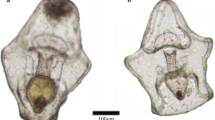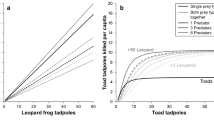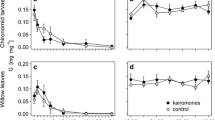Summary
An investigation of the larval dragonfly fauna associated with the plant, Sagittaria platyphylla, was conducted in a small pond. Despite the presence of several larval anisopteran species in the pond, only Pachydiplax longipennis larvae were found on Sagittaria plants. A study of the microspatial distribution of P. longipennis larvae on S. platyphylla indicated that larvae use the various regions of a plant in a highly non-random fashion. Larvae show a strong preference for the leaf axil area. A generalized predator, the bluegill sunfish (Lepomis macrochirus), was allowed to selectively eat either of two larvae placed in various plant regions. This experiment indicated that larvae in a leaf axil area were significantly less susceptible to bluegill predation than larvae positioned in other plant regions. The microspatial distribution of starved larvae revealed that larvae with high hunger levels occupied the leaf axil area significantly less than well fed larvae, suggesting 1) larvae do not use these regions as feeding sites, and 2) high hunger levels may induce a behavioral shift in habitat use, with starved larvae forced into areas of high predation risk by the need to fulfill nutritional requirements.
Similar content being viewed by others

References
Angermeier PL (1985) Spatio-temporal patterns of foraging success for fishes in an Illinois stream. Am Midl Nat 114:342–359
Ball RC, Hayne DW (1952) Effects of the removal of the fish population on the fish-food organisms of a lake. Ecology 33:41–48
Bass D, Sweet MH (1984) Do Chaoborus larvae migrate in temporary pools? Hydrobiologia 108:181–185
Baumann PC, Kitchell JF (1974) Diel patterns of distribution and feeding of bluegill (Lepomis macrochirus) in Lake Wingra, Wisconsin. Trans Amer Fish Soc 103:255–260
Benke AC, Benke SS (1975) Comparative dynamics and life histories of coexisting dragonfly populations. Ecology 56:302–317
Bohanan RE, Johnson DM (1983) Response of littoral invertebrate populations to a spring fish exclusion experiment. Freshwater Invertebrate Biol 2:28–40
Brooks JL, Dodson SI (1965) Predation, body size, and composition of plankton. Science 150:28–35
Connell JH (1975) Some mechanisms producing structure in natural communities; a model and evidence from field experiments. In: Cody ML, Diamond JM (eds) Ecology and evolution of communities. Belknap Press of Harvard University Press, Cambridge, MA, pp 460–491
Cooper SD (1984) The effects of trout on water striders in stream pools. Oecologia (Berlin) 63:376–379
Corbet PS (1962) A biology of dragonflies. Quadrangle Books, Chicago, p 247
Crowder LB, Cooper WE (1982) Habitat structural complexity and the interaction between bluegills and their prey. Ecology 63:1802–1813
Dill LM, Fraser AHG (1984) Risk of predation and the feeding behavior of juvenile coho salmon (Onorhynchus kisutch). Behav Ecol Sociobiol 16:65–71
Edmunds M (1974) Defence in animals. Longman Group Limited, Essex, p 357
Ende CN von (1979) Fish predation, interspecific predation, and the distribution of two Chaoborus species. Ecology 60:119–128
Feder HM (1972) Escape responses in marine invertebrates. Sci Am 227:92–101
Gilinsky E (1984) The role of fish predation and spatial heterogeneity in determining benthic community structure. Ecology 65:455–468
Harper JL (1969) The role of predation in vegetational diversity. In: Diversity and stability in ecological systems. Brookhaven Symp Biol 22:48–61
Heinrich B, Vogt FD (1980) Aggregation and foraging behavior of whirligig beetles (Gyrinidae). Beh Ecol Sociobiology 7:179–186
Henrikson L, Oscarson HG (1978) Fish predation limiting abundance and distribution of Glaenosorisa p. propinque (Hemiptera). Oikos 31:102–105
Hinde RA (1970) Animal behavior, 2nd ed McGraw-Hill, New York, p 876
Jeffries MJ, Lawton JH (1984) Enemy free space and the structure of ecological communities. Biol J Linn Soc 23:269–286
Johnson DM, Crowley PH (1980) Odonate “hide and seek” habitat-specific rules? In: Kerfoot WC (ed) Evolution and ecology of zooplankton communities. Univ Press of New England, Hanover, NH, pp 569–579
Johnson JA, Brodie ED Jr (1975) The selective advantage of the defensive posture of the newt, Taricha granulosa. Am Midl Nat 93:139–148
Macan TT (1966) The influence of predation on the fauna of a moorland fishpond. Arch Hydrobiol 61:432–452
Macan TT (1977) The influence of predation on the composition of freshwater animal communities. Biol Rev 52:45–70
Morin PJ (1984a) The impact of fish exclusion on the abundance and species composition of larval odonates: results of short-term experiments in a North Carolina farm pond. Ecology 65:53–60
Morin PJ (1984b) Odonate guild composition: experiments with colonization history and fish predation. Ecology 65:1866–1873
Murdock WW, Oaten A (1975) Predation and population stability. Adv Ecol Res 9:1–131
Needham JG, Westfall MJ Jr (1954) A manual of the dragonflies of North America (Anisoptera). Univ of California Press, Los Angeles, p 615
Owen D (1982) Camouflage and mimicry. Univ of Chicago Press Chicago, p 158
Paine RT (1966) Foodweb complexity and species diversity. Am Nat 100:65–76
Pope GF, Carter JCH, Power G (1973) The influence of fish on the distribution of Chaoborus spp. (Diptera) and density of larvae in the Matamek river system, Quebec. Trans Am Fish Soc 103:707–714
Sadzikowski MR, Wallace DC (1976) A comparison of the food habits of size classes of three sunfishes (Lepomis macrochirus Rafinesque, L. gibbosus (Linnaeus) and L. cyanellus Rafinesque). Am Midl Nat 95:220–225
Sih A (1982) Foraging strategies and the avoidance of predation by an aquatic insect, Notonecta hoffmanni. Ecology 63:786–796
Vermeij GJ (1982) Unsuccessful predation and evolution. Am Nat 120:701–720
Zaret TM (1980) Predation and freshwater communities. Yale Univ Press, New Haven, London, p 187
Author information
Authors and Affiliations
Rights and permissions
About this article
Cite this article
Wellborn, G.A., Robinson, J.V. Microhabitat selection as an antipredator strategy in the aquatic insect Pachydiplax longipennis Burmeister (Odonata: Libellulidae). Oecologia 71, 185–189 (1987). https://doi.org/10.1007/BF00377283
Received:
Issue Date:
DOI: https://doi.org/10.1007/BF00377283



